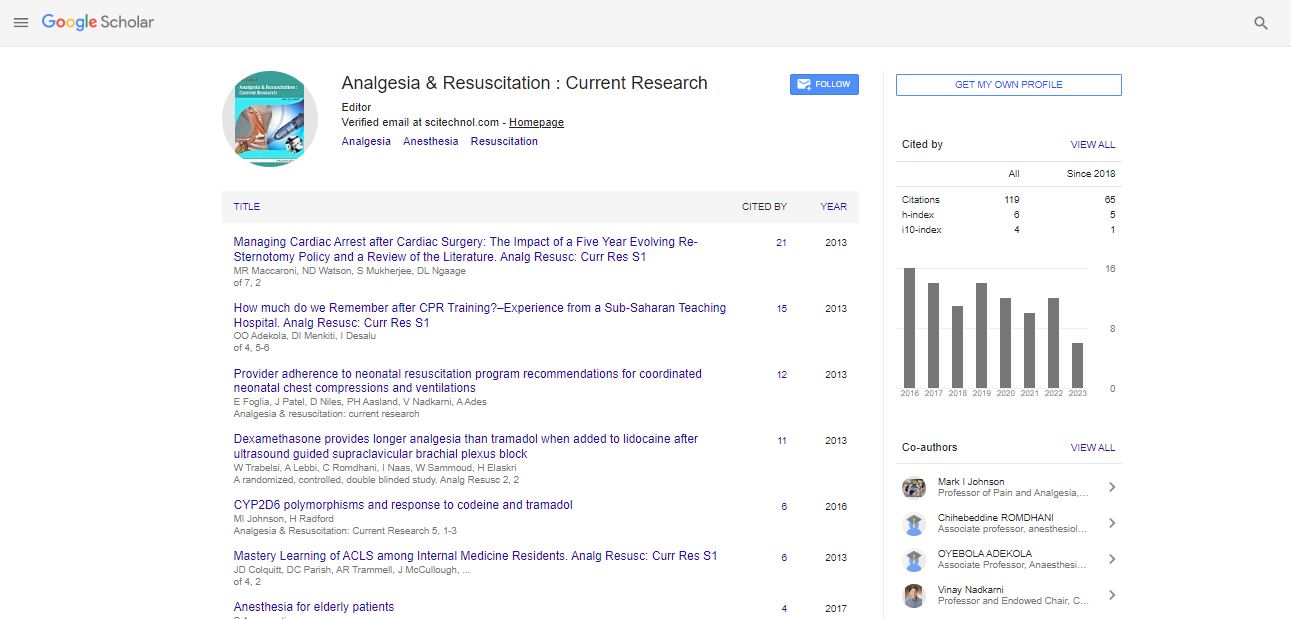Expert Review, Analg Resusc Curr Res Vol: 10 Issue: 1
New Insights into Analgesia and Resuscitation a Review
Barkin RL*
Department of Anesthesiology & Pharmacology, Rush University Medical College, USA
- *Corresponding Author:
- Robert L Barkin
Department of Anesthesiology & Pharmacology Rush University Medical College, USA
Tel: +1-470-347-1923
E-mail: mail: rbarkin@gmail.com
Received Date: December 06, 2021; Accepted Date: December 06, 2021; Published Date: December 13, 2021
Citation: Barkin RL (2021) New Insights into Analgesia and Resuscitation. Analg Resusc: Curr Res 10:1.
Copyright: © All articles published in Dental Health: Current Research are the property of SciTechnol, and is protected by copyright laws. “Copyright © 2021, SciTechnol, All Rights Reserved.
Keywords: New Insights
Editorial
Analgesic drugs act on the central and peripheral nervous system and provides relief from pain. Unlike anesthesia, analgesics show effect in the patients who are fully aware and awake. They are generally classified as opioid and non-opioid drugs. Based on extent or severity of pain, different analgesic drugs are prescribed. Resuscitation, on the other hand, is an important component of intensive care, trauma and emergency medicine for correcting physiological process. Prevention, management and aftercare of emergency situations is very critical particularly so because it is performed infrequently under stressful environment. Not a single strategy can be termed as a comprehensive since revision, training, practice, feedback and observation of the outcomes are also important. It requires good knowledge of epidemiology, aetiology, and different forms of clinical presentation, management strategies, post care and medical devices involved. Rapid progress is being made in intensive care and pain management. The evidence based articles on these topics would help the practicing physicians to follow safe and effective patient care and know about diverse management practices.
The journal ‘Analgesia & Resuscitation: Current Research’ aims to provide new observations and advancements in analgesia and resuscitation from all across the world. The current issue of the journal is constituted by original research articles on measurements of awareness to injection pain and comparative valuation of analgesics as well as case reports on intraoperative cardiac resuscitation and the importance of echocardiography and ultrasound as guide in myocardial dysfunction.
In order to monitor the depth of awareness among patients, electroencephalograms are widely used. Auditory evoked potential index and bispectral index are specifically adopted in several clinics. Cho et al. [1] have evaluated the effect of propofol injection pain on these measurements in mildly sedated patients and observed that minor alteration in the mental status caused by infusion pain was detected sensitively by AEP index than BIS while AEP was relatively better than BIS for real-time monitoring of anesthesia depth.
Zhu et al. [2] have compared the analgesic efficacy of morphine and butorphenol as they have different receptor binding properties. Based on a systematic review of information obtained from electronic databases and the statistical analysis of the data of 9 studies comprising of data of 246 patients in butorphenol group and 245 patients in morphine group, it was concluded that the analgesic efficacy was similar between the two drugs. Though butorphenol was associated with drowsiness and sedation, it offered better safety profile in terms of pruritis, nausea and vomiting. However, the authors have suggested further studies based on even larger sample size for effective conclusion.
Konishi and Bertam [3] reported a case study of 77-year old female having pulmonary hypertension undergoing semiarthroplasty repair for fractured femur neck in the left lateral decubitus position. As cardiovascular collapse was noticed, cardiac compression was done in lateral position resulting in failure. The authors emphasized on in situ intra-operative simulation for resuscitation of patients other than supine position.
Calco et al. [4] presented a case report of 35-year old women admitted for endometrial cutterage. A bedside transthoracic echocardiograph was used as point of care. The authors emphasized that the use of ultrasound eases the management of TTC syndrome and haemodynamic instability or cardiac dysfunction and allows deciding the use of most appropriate drugs. It was concluded that ecocardiography and lung ultrasound helps physicians to make decisions.
The current issue of the journal holds immense significance in furthering our understanding of anesthesia, analgesia and resuscitation under intraoperative, emergency and general treatment conditions.
References
- 1. Cho SY, Lee CW, Park HJ, Jeon WJ (2018) The Effect of Propofol Injection Pain on Auditory Evoked Potential Index and Bispectral Index. Analg Resusc: Curr Res 7:3
- 2. Zhu C, Wang C, Sun J, Li N, Liu Y, et al. (2018) Analgesic Efficacy and Safety of Butorphanol vs. Morphine in Adults: A Meta-Analysis of Randomized Controlled Trials. Analg Resusc: Curr Res 7:3.
- 3. Konishi Y, Bertram V (2018) Cardiac Resuscitation in the Lateral Position and the Potential Role of Intraoperative Simulation: A Case Report. Analg Resusc: Curr Res 7:3
- 4. Calvo A, López-Baamonde M, Masgoret P, Erdoes G, Chanzá M, et al. (2018) The Role of Bedside Transthoracic Echocardiography, Ultrasound as a Guide in Myocardial Dysfunction after Abortion: A Case Report. Analg Resusc: Curr Res 7:3.

